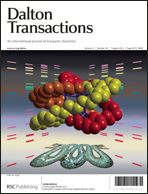Selective inclusion of PO43− within persistent dimeric capsules of a tris(thiourea) receptor and evidence of cation/solvent sealed unimolecular capsules†
Abstract
A tren-based tris(thiourea) receptor, L with electron-withdrawing p-nitrophenyl terminals has been established as a competent hydrogen-bonding scaffold that can selectively encapsulate PO43− within persistent and rigid dimeric capsules, assembled by aromatic π-stacking interactions between the receptor side-arms. A quaternary ammonium salt of PO43− capsules (complexes 1 and 1b, 2 : 1 host–guest) can reproducibly be obtained in quantitative yields by a solution-state deprotonation of [HL]+ moieties and a bound HPO42− anion of complex 1a (HPO42− complex of protonated L, 2 : 1 host–guest), induced by the presence of a large excess of anions such as HCO3−, CH3CO2−, and F−. Qualitative as well as quantitative 1H and 31P NMR experiments (DMSO-d6) have been carried out in detail to demonstrate the selective and preferential inclusion of PO43− by L in solution-states. Competitive crystallization experiments performed in the presence of an excess of anions such as HCO3−, HSO4−, CH3CO2−, NO3− and halides (F− and Cl−) further establish the phenomenon of selective PO43− encapsulation as confirmed by 1H NMR, 31P NMR, FT-IR and powder X-ray diffraction patterns of the isolated crystals. X-ray structural analyses and 31P NMR studies of the isolated crystals of phosphate complexes (1, 1a and 1b) provide evidence of the binding discrepancy of inorganic phosphates with protonated and neutral form of L. Furthermore, extensive studies have been carried out with other anions of different sizes and dimensions in solid- and solution-states (complexes 2a, 3, 4 and 5). Crystal structure elucidation revealed the formation of a solvent (DMSO) sealed unimolecular capsule in the F− encapsulated complex, 2a (1 : 1 host–guest), a CO32− encapsulated centrosymmetric molecular capsule in 3 (2 : 1 host–guest) and a cation (tetrabutylammonium) sealed SO42− encapsulated unimolecular capsule in 4 (1 : 1 host–guest). 2D-NOESY NMR experiments carried out on these capsule complexes further confirm the relevant binding stoichiometry of complexes (2a–4) except for the PO43−-encapsulated complex (1b) which showed a 1 : 1 host–guest stoichiometry in solution.


 Please wait while we load your content...
Please wait while we load your content...